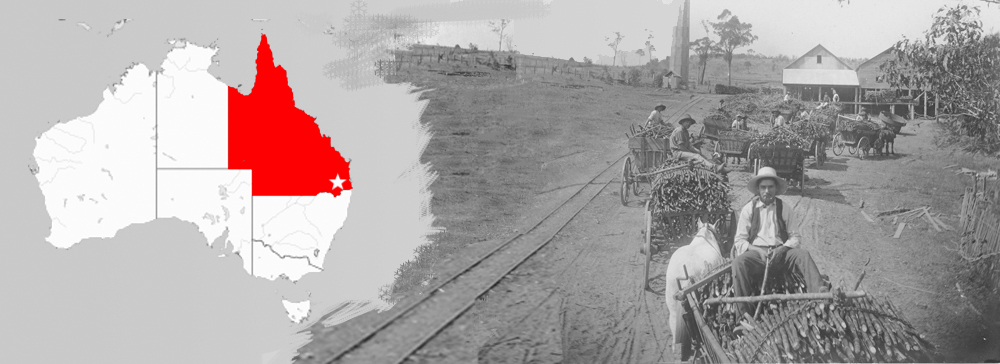 Sugar
cane carting at Marburg Mill c1907-1908
Sugar
cane carting at Marburg Mill c1907-1908 This block will be replaced by LeftMenuGaffey (orByrnes) when the page is served from a server.

- Father:
- George Dance (b. 1837, Hampshire, England)
- Mother:
- Martha Amelia Blandford b. (1843, Martin, Wiltshire)
- Birth:
- August 27, 1866 in Tamerton Foliet, Devon, England[1]
- Occupation:
- "Farmer's son" (1881) (age 14)[2] Farmer (1880s-1924)
- Immigration:
- Australia (1885)
- Death:
- Dec 16, 1924, Marburg, Qld
- Marriage:
- 1. Amalia Christina Retchslag (June 6 1888 in Lutheran church, Walloon, near Marburg, Queensland)[3]
- Children:
- Mary Amelie Dance (Dec 21 1888-Apr 2, 1889)
- William Frederich Dance (Feb 2 1890-Feb 11 1965)
- Amelia (Lily) Dance (Jul 17 1891-Jul 30, 1959), married Thomas Byrnes, 1913, Ipswich Q.
- Bessie Emilie Dance (Jan 4 1893-1967)
- Archie George Dance (Feb 14 1895-1959)
- Charles Henry Dance (May 3 1896-Sep 8 1954)
- Edwin Evan Dance (Aug 23 1897-Jan 19 1969)
- Elsie Violet Dance (Aug 19 1898-Sep 25 1997)
- Francis Herbert Dance (Oct 5 1899-Oct 25, 1962)
- Leslie Clarence Dance (Jan 12 1901-Mar 12 1943)
- Ronald Blandford Dance (Mar 2 1902-Mar 20 1953)
- Robert Roy Dance (Aug 13 1903-Jun 16 1904)
- Marriage:
- 2. Bertha Smith née Ruthenberg (Sep 19 1910)
- Children:
- Frank Henry Dance (b. Jan 28 1912)
- Stella Evelyn Dance (b. Apr 28 1914)
- Claude Stanley Dance (b. Feb 1 1917)
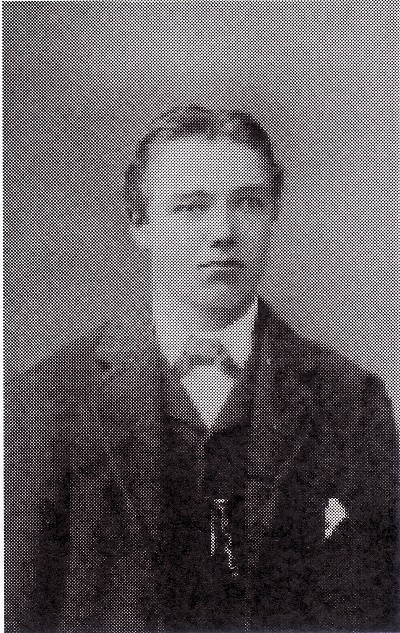
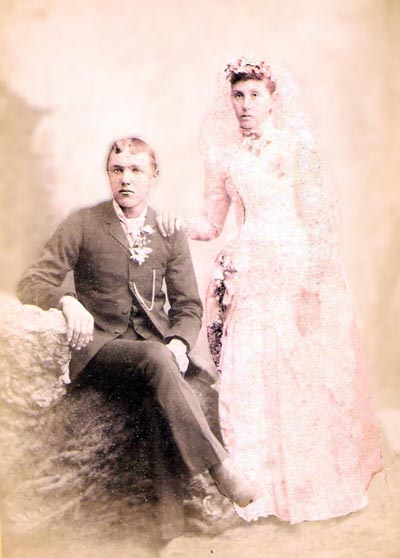
William and his brother George were followed to Queensland some years later, by a third Dance - their nephew, Robert. Robert, eldest son of William's brother Ernest Robert, aimed to settle with his family in Australia, but tragedy struck - after their arrival, his wife died in childbirth, and Robert lost the drive needed to succeed in the new country. Although one of his sons stayed on to marry an Australian and settle in the colonies, Robert took the rest of his children and returned to England.[7] )
George was the first of the two brothers to marry. In February 1888, he wed Wilhelmine Schmidchen, and a short time later, William also married into a German family. William had started working in the butcher shop of another immigrant, a German farmer, Christian Retschlag, and there met 16-year-old Amalia Retschlag, daughter of Christian and his wife Emelie. In June 1888, the young couple (right) married in the Lutheran Church, in nearby Walloon.[8]
The young couple's first child was a girl, Mary Emelie, born in December 1888, but the baby did not survive even four months.
William and Amalia (or Emily, as she was known) continued their farming life on a 100 acre dairy property at Kirkheim (now Haigslea) near the Retschlag family property on Linnings Road, and in 1891, William was still bringing in extra money as a butcher. He was given a helping hand financially by his father-in-law (in his will, Christian Retschlag went so far as to forgive the debt of £200 owed to him by William).
William was something of an entrepreneur, building a block of shops in the town of Marburg. He became a prominent citizen in the Marburg Valley, a staunch supporter of the Rosewood Masonic Lodge, and a keen horse-breeder as a sideline to his farming enterprises.[9]
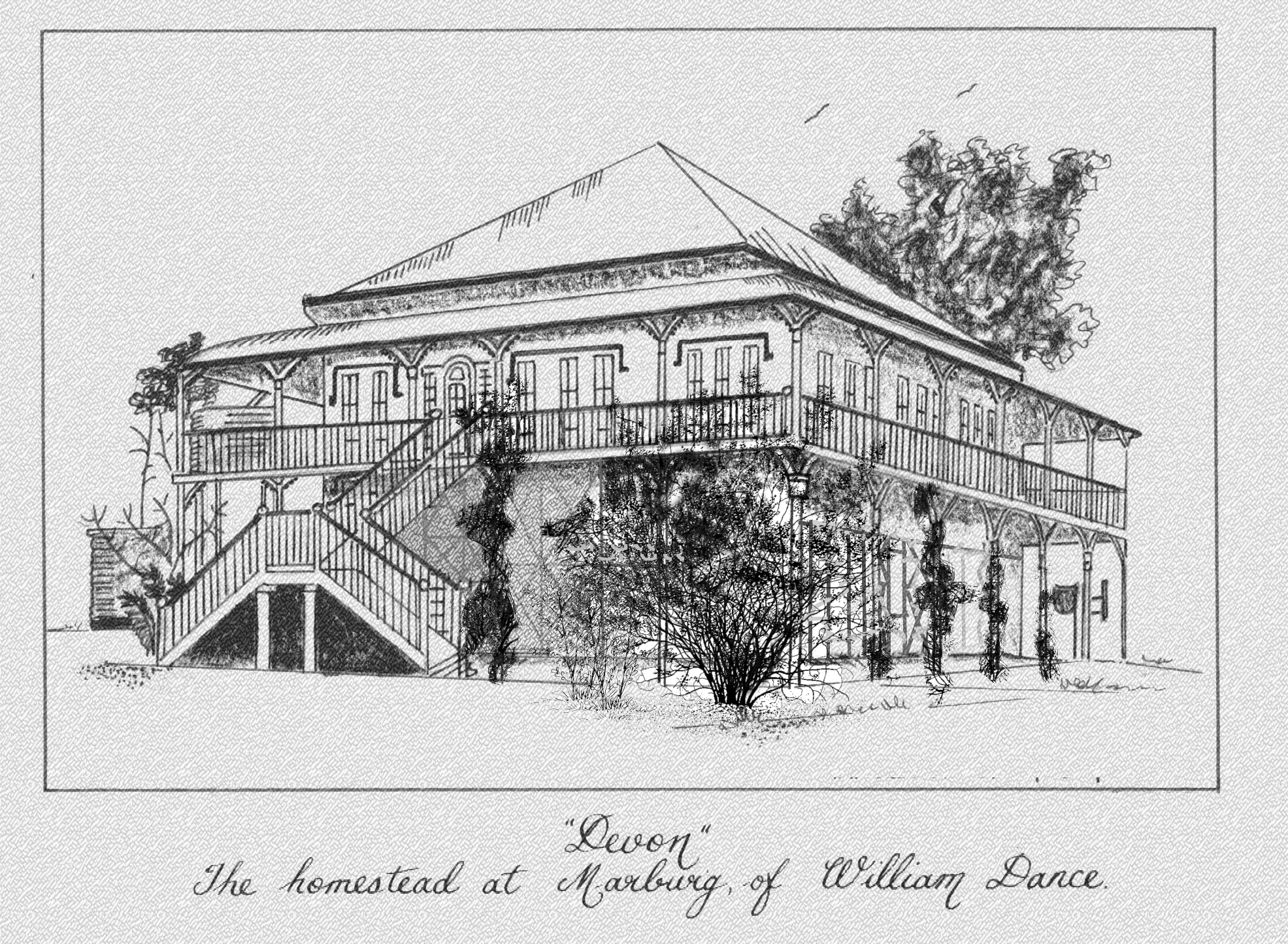
The house had 11 rooms: five bedrooms and a sitting room upstairs, with an office, double dining room, sewing room, store room and a small bedroom downstairs. The kitchen was on the left, adjoining the lower level. Unfortunately, the house no longer exists, and this drawing, from a photocopy may be the only surviving record. Some artistic license has been taken with the front door and windows, as the photocopy was not sufficiently detailed for a reliable reconstruction. The house was demolished in the 1930s, and another house, "Heathmore" was built by new owners, the family of William Freeze, using materials from the original homestead.
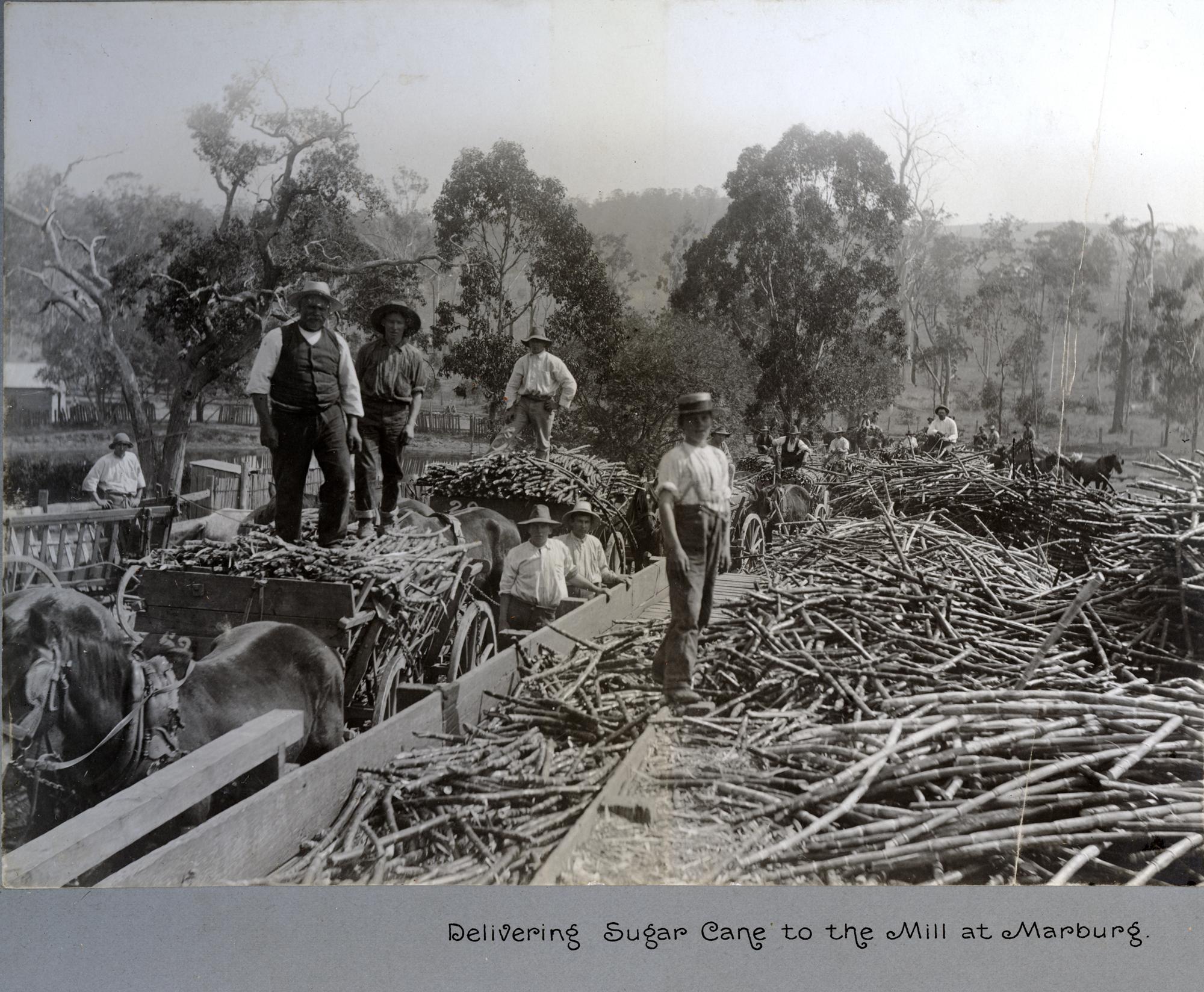
Early in his farming days when Marburg farms included sugar cane growing, Bill Dance made use of Pacific Islanders enticed to Queensland as cheap labour by recruiters of dubious repute, known as "blackbirders". These people were conscripted, often under false pretences, from the Pacific islands to work on Queensland canefields, carrying out work that Europeans either wouldn't do, or couldn't do efficiently or cheaply enough to satisfy the employers. This form of labour indenture was later found to be akin to slavery. It was discontinued (but not through any humanitarian reasons) in the early 1900s by the newly-created Commonwealth of Australia, which tried to ensure the young nation was peopled almost solely by white British stock.
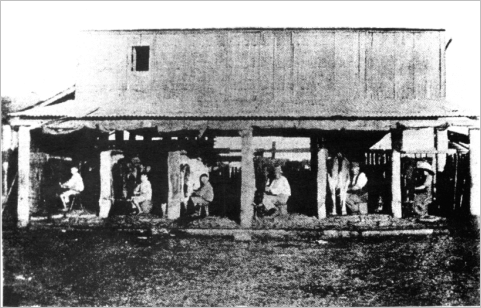
The milking shed on the Dance property, c1908.
In a letter home to his family in England, William sounds less than enamoured of all the children. After the birth of his daughter Stella in 1914, he wrote:
In the same letter, William says he "has just bought another farm: with a brick house on it which belong to an old english (sic) farmer" and he says of Queensland: "..the old State is looking prosperous: in fact, I think it the paradise of the world", and he refers, without explanation, to the ill-feeling that existed between himself and his older brother, George.
William had hoped to return home to England for a visit within twelve months . He wrote the letter detailing his plans in May 1914 - by August that year, Europe was embroiled in World War 1. This catastrophe blocked any thought of travel to England (for the full text of this letter, click here]. Instead, he focused on expanding his business interests, and by the end of the War, had branched out with building a block of shops, the Dance Buildings, on the main intersection in Marburg.[11]. Among his tenants were a doctor, a solicitor, a draper, the Post Office, a café and Bielefelds’ store.[12] Soon after, when he was only 52, William decided the time had come for him to retire, and enjoy some of the proceeds of his years of hard work.
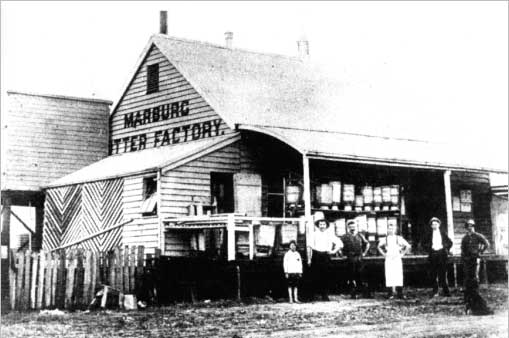
However, a fire at the Marburg butter factory may have interfered with his plans. The fire was blamed in part for ill health leading to William's death. According to the Queensland Times, he was among those who fought the fire, trying to prevent the blaze spreading. Some ammonia exploded, and William was knocked unconscious.[13]
In December, 1924, when he was only 58, William died at Marburg. He left a substantial estate. His wife Bertha inherited one third of William's property, and the remaining two thirds was divided (a little unequally) between his 13 surviving children, nine of whom received £500 each, the other four £100 less, still a considerable sum in those days.[14]
Bertha’s daughter in law, Ellie Dance (widow of Frank) says there was some family bitterness over the terms of the will and that William’s second family was treated badly. She believes Bertha’s share was only the family home (“and you can’t live on that”), and afterwards his widow had to take in boarders to make ends meet. Frank, 12 years old at the time of his father’s death, went to work on the roads to help his mother financially. In later years, Frank borrowed money to buy the Dance bakery established by his older half-brother Archie, considered the businessman of the family.
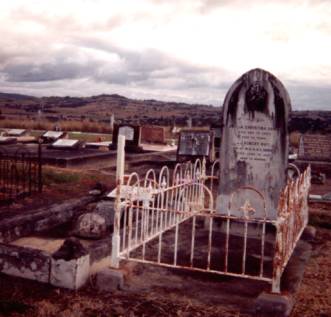
(left): The Dance family graves in the Marburg Anglican cemetery. William is buried with his second wife Bertha (neé Ruthenberg) in the low-set grave alongside the elaborate memorial he erected for his young first wife Amalia (neé Retschlag) and their infant son Robert.
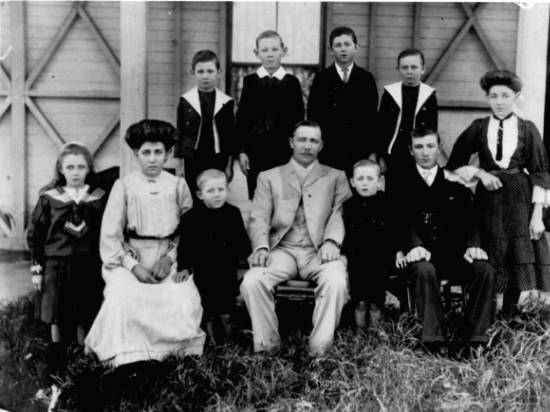
The family of William Dance, at Marburg, c1905
Back row (from left): Archie, Charlie, Francis, Edwin
Front (from left): Elsie, Lily, Ronald, William Henry, Leslie, William, Bessie (standing)
[1] British 1881 Census
[2] as above.
[3] William & Amalia’s Queensland marriage certificate.
[4] Neville Eveans, Retschlag Descendants in Australia, p 84, and William’s own death certificate
[5] He travelled on the New
Guinea, of 2000 tons, which sailed from London on December 4,
arriving in Brisbane on February 8, 1885.
[6] Queensland Times,
Ipswich, Wednesday December 17, 1924, p9
[7] Recollections of William's grandson, George Wilson of Toowoomba (January 2000); and of William's grand-nephew, Ian Dance, son of Robert and Florence Dance.
[8] This church was demolished early in the 20th century.
[9] Personal recollections in February 2000 of William Dance's grandson, (Henry) George Wilson (son of William's daughter Elsie). George also recalled the tales of the kanaka workforce
[10] as above
[11] Marburg 1879-1988 (author and publisher details not recorded).
[12] The Dance Buildings were gutted by fire in 1927, two years after William died.
[13] Queensland Times, December 17, 1924
[14] Recollections of William's grandson, Peter Byrnes, confirmed in part by William's will